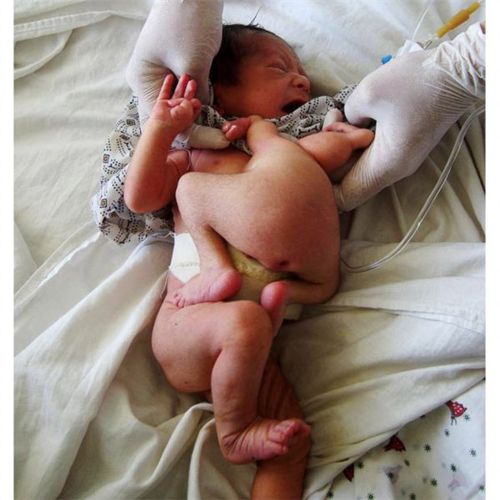
A parasitic twin (also known as an asymmetrical or unequal conjoined twin) is the result of the processes that also produce vanishing twins and conjoined twins, and may represent a continuum between the two.
Parasitic twins occur when a twin embryo begins developing in utero, but the pair does not fully separate, and one embryo maintains dominant development at the expense of the other.
Unlike conjoined twins, one ceases development during gestation and is vestigial to a mostly fully formed, otherwise healthy individual twin. The undeveloped twin is defined as parasitic, rather than conjoined, because it is incompletely formed or wholly dependent on the body functions of the complete fetus. The independent twin is called the autosite.
TYPES
- Conjoined parasitic twins joined at the head are described as craniopagus or cephalopagus, and occipitalis if joined in the occipital region or parietalis if joined in the parietal region.
- Craniopagus twin is a general term for a parasitic head attached to the head of a more fully developed fetus or infant.The parasitic head may also have an underdeveloped body with no functioning organs.
- Fetus in fetu sometimes is interpreted as a special case of parasitic twin, but may be a distinct entity.Fetus in fetu means “fetus inside fetus” and describes a condition in which one functioning twin has an underdeveloped twin inside of its body, usually in the abdomen. There are two theories of origin concerning "fetus in fetu". One theory is that the mass begins as a normal fetus but becomes enveloped inside its twin. The other theory is that the mass is a highly developed teratoma.
- The twin reversed arterial perfusion, or TRAP sequence, results in an acardiac twin, a parasitic twin that fails to develop a head, arms and a heart. The parasitic twin, little more than a torso with or without legs, receives its blood supply from the host twin by means of an umbilical cord-like structure, much like a fetus in fetu, except the acardiac twin is outside the host twin's body. The blood received by the parasitic twin has already been used by normal fetus, and as such is already de-oxygenated, leaving little developmental nutrients for the acardiac twin. Because it is pumping blood for both itself and its acardiac twin, this causes extreme stress on the normal fetus's heart. Many TRAP pregnancies result in heart failure for the healthy twin.

An epigastric parasite describes an incomplete twin with usually just a torso or legs attached to the functioning twin’s abdomen. In some cases, there is also an undeveloped head imbedded in the autosite's abdomen.
PROPOSED MECHANISM
Incomplete twinning has been proposed as a mechanism for how parasitic twins arise. Instead of one egg separating into two eggs that give rise to two fetuses, incomplete twinning occurs when one egg does not fully separate. Researchers have also investigated the role of the protein Sonic Hedgehog (SHH) in establishing the midline of the body during development. A deficiency of SHH during development leads to stunted midline development, and disorders such as fused eyes (cyclopia), a brain lacking hemispherical separation (holoprosencephaly), and fusion of the legs and feet (sirenomelia). Conversely, an increase in SHH during development leads to an over-expression of midline features. In chick embryo experiments, an increase in SHH led to larger than usual spacing between the eyes and duplication of beaks, a condition sometimes referred to as craniofacial duplication. The duplication of features associated with parasitic twinning may be caused by an over-expression of SHH rather than the result of incomplete twinning. However, because there are so many different types of parasitic twins, discovering a single mechanism of this developmental anomaly has proven difficult.



SOURCE: embryo.asu.edu
WIKIPEDIA
Vital information,thanks.
ReplyDeletewow!!!!
ReplyDeleteVery sexy.
ReplyDelete